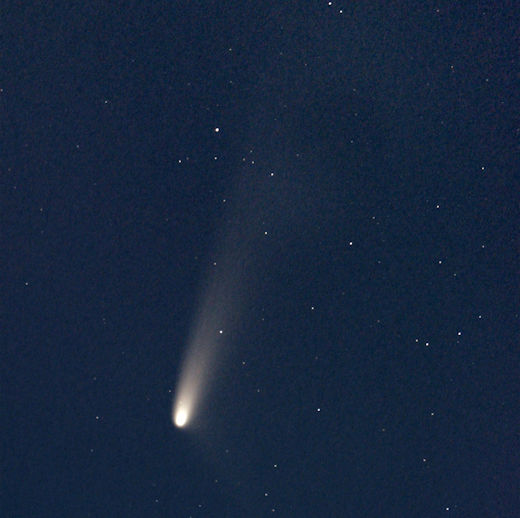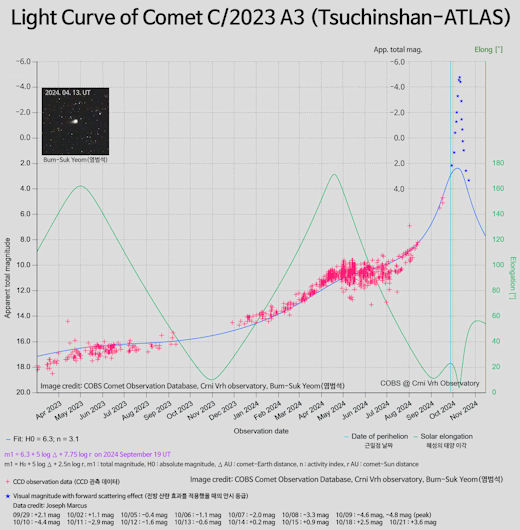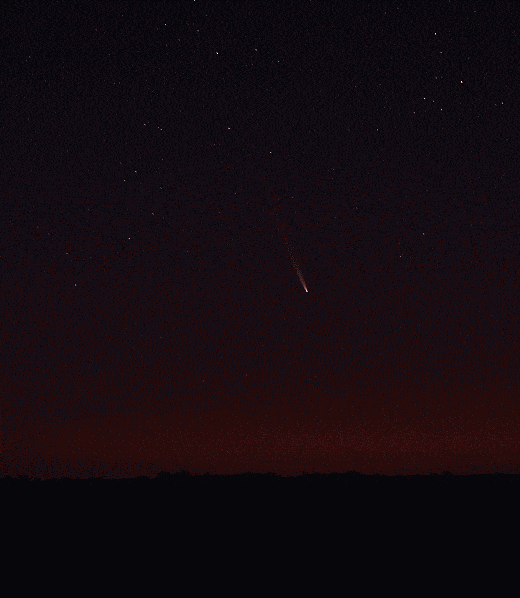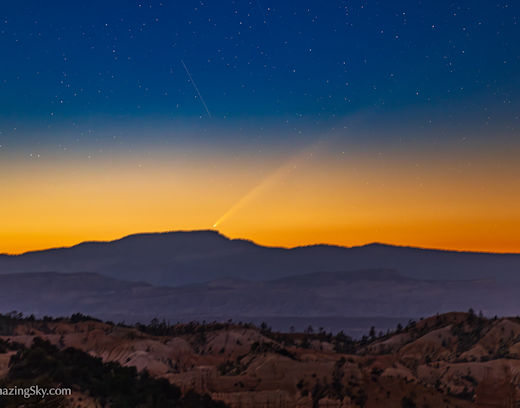[ Skywatchers ] [ Main Menu ]
48466

From: ryan, [DNS_Address]
Subject: A BRGHT COMET IS APPROACHING EARTH
|
A BRGHT COMET IS APPROACHING EARTH (UPDATED): Comet Tsuchinshan-ATLAS (C/2023 A3) has just emerged from behind the sun, and its appearance has astronomers buzzing with anticipation. "The comet is brightening rapidly," says Australian astrophotographer Michael Mattiazzo, who has been monitoring the comet in dawn twilight: Comet Tsuchinshan-ATLAS at dawn on Sept. 21st over Swan Hill, Australia "The comet was only 6 degrees above the horizon when I photographed it on Sept. 21st," says Mattiazzo. "Using 15x70mm binoculars, I estimated its visual magnitude to be +3.9." This is very good news. Some astronomers predicted Comet Tsuchinshan-ATLAS would fall apart during its transit behind the sun. The fact that it is still intact and healthy means we could witness a bright naked-eye comet next month. "Prospects remain excellent for a visually impressive evening display in mid-October," says Qicheng Zhang of the Lowell Observatory. "Weather permitting, the entire Northern Hemisphere should be able to see Comet Tsuchinshan-ATLAS." Nick James of the British Astronomical Association just wrote an article anticipating the bright comet. "It makes its closest approach to Earth on October 12 when it will be 0.47 au away in the constellation of Virgo," he says. "There is a possibility that the comet will be at a negative magnitude as it emerges into the evening sky from Oct. 10th onwards."  This light curve from astronomer Bum-Suk Yeom shows a huge spike in the comet's brightness around Oct. 9-10. [more] "Negative magnitude" means the comet could be visible in broad daylight, especially on Oct. 9th when light from the nearby sun will be forward scattered by comet dust, amplifying the comet's brightness. "[Daylight photography of the comet] should only be attempted if you know what you are doing," cautions James. "The sun will be very close by and this is potentially a very dangerous observation, similar to observing Venus at inferior conjunction." It's been done before, though. Witness Comet McNaught in 2007, which was seen in broad daylight by thousands of observers. Could a repeat display be in the offing? Stay tuned for updates as Comet Tsuchinshan-ATLAS approaches Earth. |
Responses:
[48469] [48471] [48473] [48474] [48481] [48475] [48470] [48468]
48469

From: ryan, [DNS_Address]
Subject: Re: A BRGHT COMET IS APPROACHING EARTH
|
BRIGHT MORNING COMET: The week has barely begun, and Comet Tsuchinshan-ATLAS (C/2023 A3) has already tripled in brightness. "The change of the comet compared to yesterday has been exponential," reports Frank A. Rodriguez, who saw the comet today just before sunrise over Gran Canaria island: The view is about to improve. Every day this week, the comet will climb higher in the morning sky, peaking in altitude between Sept. 26th and 29th. For some observers, the comet will be as high as 16 degrees above the horizon, well clear of the brightest twilight. An altitude chart prepared by Nick James of the British Astronomical Association can help you plan your observation; locations in the tropics and near the equator are favored. This morning in Chile, Yuri Beletsky worried that low clouds would block his view. "We got really lucky when the comet suddenly appeared just above the cloud deck," he says. Clearly, Comet Tsuchinshan-ATLAS is living up to the hype. Later this week the comet will pass by the sun near the orbit of Mercury where it will receive a brightening dose of solar heat. Then it will proceed toward Earth for a close encounter (0.47 AU) and possible daytime apparition during the second week of October. |
48471

From: ryan, [DNS_Address]
Subject: Re: A BRGHT COMET IS APPROACHING EARTH
|
BRIGHT MORNING COMET: Set your alarm for dawn. There's a bright comet in the morning sky. "The celestial wonder C/2023 A3 (Comet Tsuchinshan–ATLAS) is gracing the sunrise of the Northern Hemisphere!" says Alireza Vafa, who sends this picture from the Alborz Mountains of Iran: "Mount Damavand—the highest peak in the Middle East—provided the perfect backdrop for this cosmic event," he says. "As the clock ticked down to just 40 minutes before sunrise, the comet revealed itself, shining brilliantly with a magnitude brighter than +3. Its brilliance was somewhat subdued against the illuminated dawn sky, but this is merely the beginning of a dazzling display in the days to come." He's right. The view is about to improve. Every day this week, the comet will climb higher in the morning sky, reaching a peak between Sept. 26th and 29th. For some observers, the comet will be as high as 16 degrees above the horizon. This chart prepared by Nick James of the British Astronomical Association shows how the comet's height above the horizon depends on latitude. Note that it is visible in both hemispheres. On Sept. 27th, the comet will pass by the sun near the orbit of Mercury where it will receive a brightening dose of solar heat. Then it will proceed toward Earth for a close encounter (0.47 AU) on Oct. 12th. Around that time, the comet might be bright enough to see in broad daylight. Stay tuned! |
48473

From: ryan, [DNS_Address]
Subject: Re: A BRGHT COMET IS APPROACHING EARTH
|
COMET TSUCHINSHAN-ATLAS IS HEADING FOR EARTH: Yesterday, Comet Tsuchinshan-ATLAS (C/2023 A3) made its closest approach to the sun. Now, its heading for Earth. Michael Mattiazzo photographed the comet on Sept. 27th rising over Lake Boga in Victoria, Australia: Mattiazzo's time-lapse shows how minutes matter. The comet rises just before the sun. As it climbs out of low clouds and haze, the surrounding sky brightens rapidly. Actually seeing the comet with the human eye requires a short-lived combination of rising altitude and waning darkness. "Using 8x40mm binoculars, I estimate the comet's magnitude was +2.8 with a 7 degree tail," says Mattiazzo. "It was naked-eye visible, but not yet conspicuous. This will change over the next couple of weeks when, on Oct. 12, the comet has an Earth approach of only 70 million kms (0.43 AU)," he adds. Comet Tsuchinshan-ATLAS could become very bright indeed. On Oct. 9th, it will pass between Earth and the sun. Sunlight forward scattered by comet dust will amplify the comet's brightness to negative magnitudes. If the most optimistic predictions ( m < -5.0) come true, it could be visible even in broad daylight like Comet McNaught in 2007. |
48474
From: Redhart, [DNS_Address]
Subject: Re: A BRGHT COMET IS APPROACHING EARTH
|
was up before sunrise this morning and went out and attempted to find it...couldn't yet. Looks like I have some more time and will keep looking. |
48481

From: ryan, [DNS_Address]
Subject: Re: A BRGHT COMET IS APPROACHING EARTH
|
i think it is hard to see with the naked eye because it is not in the night sky at present...this pic was a 15 second exposure... COMET TSUCHINSHAN-ATLAS CONTINUES TO BRIGHTEN: Comet Tsuchinshan-ATLAS (C/2023 A3) has become so bright, you can take a picture like this in less than 1 minute: "This is a single 15-second exposure with my Canon R5 camera at ISO 800," says Alan Dyer, who watched the comet rise over Bryce Canyon National Park at dawn on Sept. 28th. "The location was Fairyland Point looking almost due east." "The comet was not visible to the naked eye, but could be seen in 10x50 binoculars — indeed, its tail rose first and was visible before the head cleared the distant butte," says Dyer. "The full field of view is 15º by 10º so the tail is at least 7º to 8º long." The comet is currently as bright as a +2.5 magnitude star. In a dark sky, that would be very easy to see. At sunrise, it's not so easy, but this could soon change. On Oct. 9th, the comet will pass between Earth and the sun. Sunlight forward scattered by comet dust will amplify the comet's brightness to negative magnitudes. If the most optimistic predictions ( m < -5.0) come true, it could be visible even in broad daylight like Comet McNaught in 2007. |
Responses:
None
48475
From: Eve, [DNS_Address]
Subject: Re: A BRGHT COMET IS APPROACHING EARTH
|
This animated visual may help it is focused on 34 degree latitude to give you an idea: |
Responses:
None
48470
From: sher, [DNS_Address]
Subject: Re: A BRGHT COMET IS APPROACHING EARTH
| Beautiful photo. |
Responses:
None
48468
From: sher, [DNS_Address]
Subject: Re: A BRGHT COMET IS APPROACHING EARTH
URL: https://en.m.wikipedia.org/wiki/C/2023_A3_(Tsuchinshan%E2%80%93ATLAS)
|
“Next perihelion 27 September 2024 18:00 ± 20 minutes “ |
Responses:
None
[ Skywatchers ] [ Main Menu ]